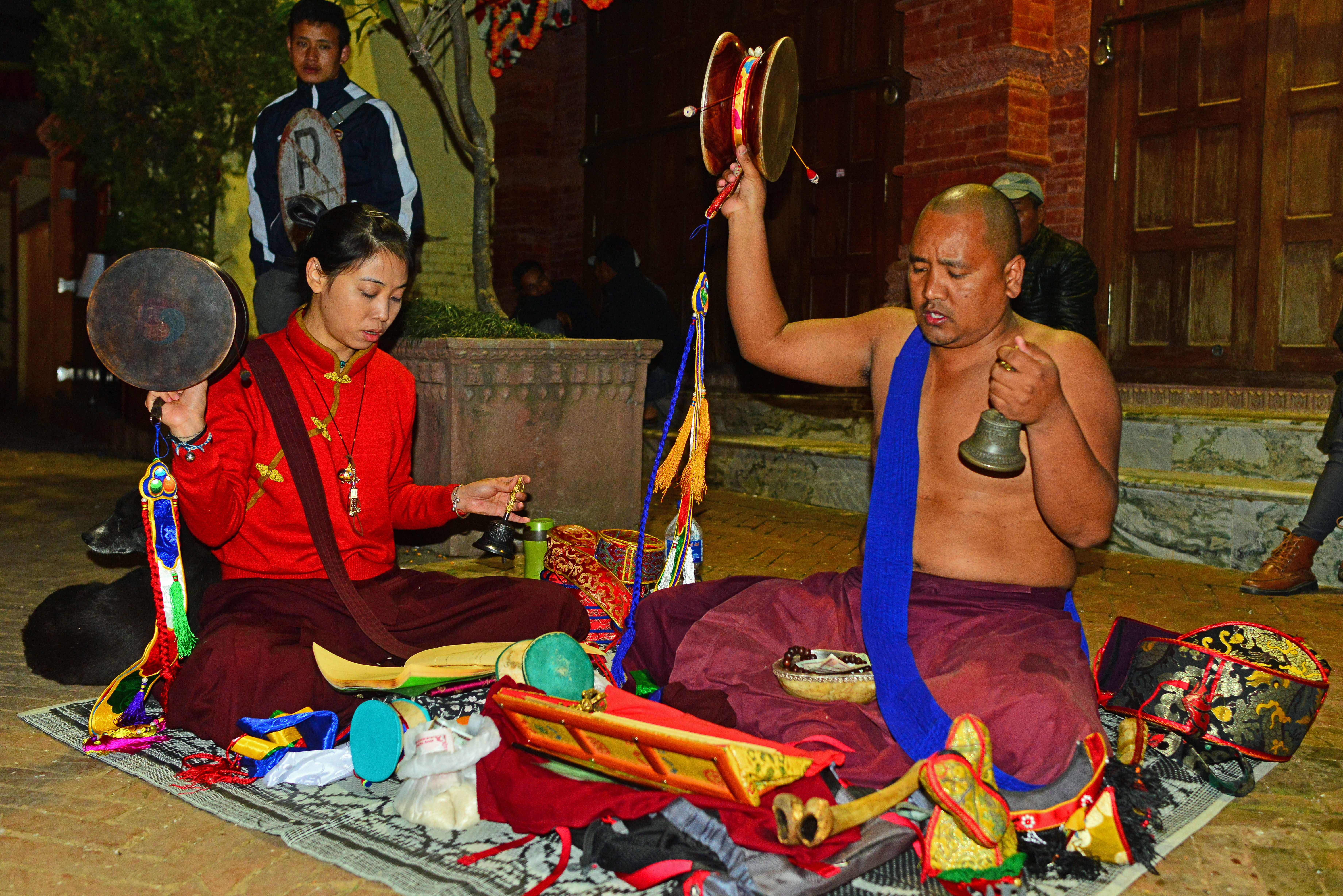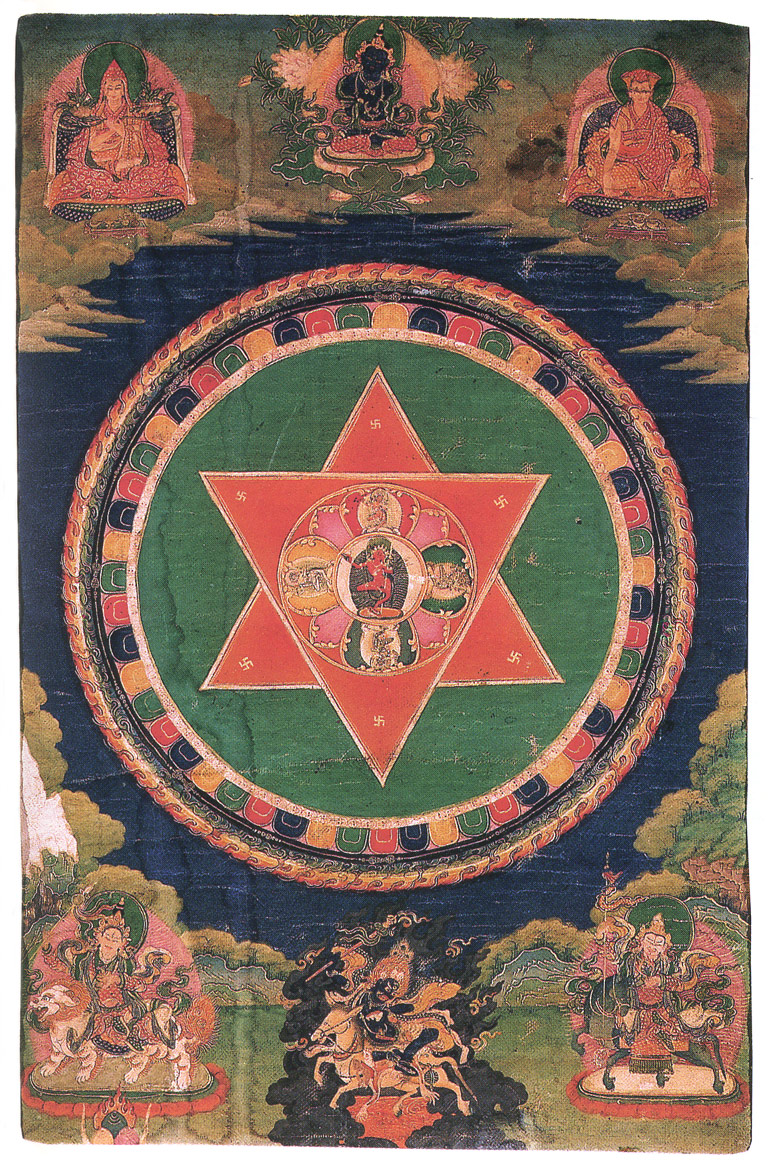|
Nyönpa
The term ''nyönpa'' ( "mad one(s)"; Sanskrit ''avadhūta'') may refer to a group of Tibetan Buddhist yogis or a single individual belonging to this group. They were mainly known for their unusual style of teaching, to which they owed their names. Spiritual practices Recent scholarship has helped to illuminate many distinguishing features of the religious practices the nyönpa; these practices are sometimes referred to in the literature as ''The Practice of Observance''. ''The Practice of Observance'' takes as its foundation the philosophy of tulshuk or chöpa or even tulshuk chöpa. This religious philosophy is the common thread in the following spiritual practices of the nyönpa: The nyönpa is essentially a free spirit who follows the rule of spontaneity and intuition, not subject to any external book of rules....he is one dedicated to renunciation and the path of enlightenment who does not fit within the disciplines and practises of the formal orders. *wandering homeles ... [...More Info...] [...Related Items...] OR: [Wikipedia] [Google] [Baidu] |
Avadhuta
''Avadhūta'' ( IAST ', written as अवधूत) is a Sanskrit term from the root 'to shake' (see V. S. Apte and Monier-Williams) that, among its many uses, in some Indian religions indicates a type of mystic or saint who is beyond egoic-consciousness, duality and common worldly concerns and acts without consideration for standard social etiquette. Avadhūta is a Jivanmukta who gives his insight to others and teaches them about his realisation of the true nature of the ultimate reality (Brahman) and self ( Ātman) and takes the role of a guru to show the path of ''moksha'' to others. Some Avadhūta also achieve the title of ''Paramahamsa''. Similar figures (colloquially called 'mad/crazy monks') are also known in Buddhist traditions, such as the medieval Zen monk Ikkyū, and the 20th century Tibetan tulku Chögyam Trungpa Rinpoche. In Tibetan Buddhism the equivalent type is called a nyönpa (). Types of avadhūtas Feuerstein (1991: p. 105) frames how the term ''avadhūt ... [...More Info...] [...Related Items...] OR: [Wikipedia] [Google] [Baidu] |
Thang Tong Gyalpo
Thangtong Gyalpo () (1385 CE–1464 CE or 1361 CE–1485 CE), also known as Chakzampa, the "Iron Bridge Maker" (), Tsöndrü Zangpo "Excellent Persistence" (), and the King of the Empty Plain.Sarah Harding. Niguma, Lady of Illusion. Snow Lion Publications. 2010. p. 265, n. 84 He was also known by a variation of this name, Madman of the Empty Valley. He was a great Buddhist adept, a Chöd master, yogi, physician, blacksmith, architect, and a pioneering civil engineer. He is considered a mind emanation of Padmasambhava and a reincarnation of Dolpopa Sherab Gyaltsen. He founded the Iron Chain lineage of the Shangpa Kagyu school of Tibetan Buddhism, and he recognized the first Samding Dorje Phagmo, Chökyi Drönma (1422–1455), the female incarnation lineage of Vajravārāhī. Thangtong Gyalpo is said to have built 58 iron chain suspension bridges around Tibet and Bhutan, several of which are still in use today. He also designed and built several large stupas of unusual design ... [...More Info...] [...Related Items...] OR: [Wikipedia] [Google] [Baidu] |
Chöd
Chöd ( lit. 'to sever') is a spiritual practice found primarily in the Yundrung Bön tradition as well as in the Nyingma and Kagyu schools of Tibetan Buddhism (where it is classed as Anuttarayoga Tantra). Also known as "cutting through the ego," the practices are based on the Prajñāpāramitā or "Perfection of Wisdom" sutras, which expound the "emptiness" concept of Buddhist philosophy. According to Mahayana Buddhists, emptiness is the ultimate wisdom of understanding that all things lack inherent existence. Chöd combines prajñāpāramitā philosophy with specific meditation methods and tantric ritual. The chod practitioner seeks to tap the power of fear through activities such as rituals set in graveyards, and visualisation of offering their bodies in a tantric feast in order to put their understanding of emptiness to the ultimate test. Definition and Sanskrit ''chedasādhanā'' both literally mean "cutting practice". In Standard Tibetan (the prestige dialect asso ... [...More Info...] [...Related Items...] OR: [Wikipedia] [Google] [Baidu] |
Tsangnyön Heruka
Tsangnyön Heruka ( "The Madman Heruka from Tsang", 1452-1507), was an author and a master of the Kagyu school of Tibetan Buddhism. Born in Tsang, he is best known as a biographer and compiler of the ''Life of Milarepa'' and ''The Collections of Songs of Milarepa'', both classics of Tibetan literature. Life Tsangnyön Heruka was a nyönpa () or "religious madman", whose eccentric ways of life were considered signs of spiritual realization. He was ordained as a śrāmaṇera, but at the age of 21 renounced his vows and trained under various tantric yogis from different schools. His first teacher was Shara Rabjampa Sanggye Sengge (1427–1470) who conveyed to him the "Aural Transmissions" (''snyan brgyud'') of the Kagyu tradition. Tsangnyön spent years in solitary retreat on Tsari in southern Tibet, which is the major sacred mountain retreat for the Kagyu school. He also studied the tantras in Pelkhor Chode Monastery in Gyantse for three years. After Heruka left the monastery, ... [...More Info...] [...Related Items...] OR: [Wikipedia] [Google] [Baidu] |
Samding Dorje Phagmo
The Samding Dorje Phagmo () is the highest female incarnation in Tibet''The Power-places of Central Tibet: The Pilgrim's Guide'', (1988) p. 268. Keith Dowman. . and the third highest-ranking person in the hierarchy after the Dalai Lama and the Panchen Lama. She was listed among the highest-ranking reincarnations at the time of the 5th Dalai Lama, recognized by the Tibetan government and acknowledged by the emperors of Qing China. In her first incarnation, as Chökyi Drönma (1422 CE–1455 CE), she was the student and consort of the famous polymath Thang Tong Gyalpo, who first identified her as an emanation of Vajravārāhī, and the consort of Bodong Panchen. The seat of the Samding Dorje Phagmo is at Samding Monastery, in Tibet. History and background The seat of the Samding Dorje Phagmo is at the Samding Monastery "Temple of Soaring Meditation." The Samding Monastery is associated with the Bodong school of Tibetan Buddhism. It was unique because half of the inhabitants were ... [...More Info...] [...Related Items...] OR: [Wikipedia] [Google] [Baidu] |
Tulku
A ''tulku'' (, also ''tülku'', ''trulku'') is a reincarnate custodian of a specific lineage of teachings in Tibetan Buddhism who is given empowerments and trained from a young age by students of his or her predecessor. High-profile examples of tulkus include the Dalai Lamas, the Panchen Lamas, the Samding Dorje Phagmos, the Karmapas, Khyentses, the Zhabdrung Rinpoches, and the Kongtruls. Nomenclature and etymology The word སྤྲུལ or 'sprul' (Modern Lhasa Tibetan ) was a verb in Old Tibetan literature and was used to describe the བཙན་པོ་ btsanpo ('emperor'/天子) taking a human form on earth. So the ''sprul'' idea of taking a corporeal form is a local religious idea alien to Indian Buddhism and other forms of Buddhism (e.g. Theravadin or Zen). Over time, indigenous religious ideas became assimilated by the new Buddhism; e.g. ''sprul'' became part of a compound noun, སྤྲུལ་སྐུ་'sprul.sku' ("incarnation body" or 'tülku', and 'btsan' ... [...More Info...] [...Related Items...] OR: [Wikipedia] [Google] [Baidu] |
Vajravārāhī
In Tibetan Buddhism, Vajravārāhī ("The Diamond Sow", Dorje Pakmo) is a wrathful form of Vajrayogini associated particularly with the ''Cakrasaṃvara Tantra'', where she is paired in yab-yum with the Heruka Cakrasaṃvara. Judith Simmer-Brown writes that "Vajravārāhī's iconography is very similar to that of Vajrayoginī, but she often has more prominent fangs and a more wrathful expression, and she prominently displays a sow's head above her right ear." Although there are practices of Vajravārāhī in all schools of Tibetan Buddhism, she is particularly associated with the Kagyu school and is one of the main yidam practices of that school. Her tulkus, the Samding Dorje Phagmo, are associated with the Bodongpa, a little-known school of Tibetan Buddhism. Iconography Vajravārāhī is one of the most popular female Tantric deities in all traditions of Tibetan Buddhism. Although there are several forms, the basic iconography is that she has one face, (usually) two hands an ... [...More Info...] [...Related Items...] OR: [Wikipedia] [Google] [Baidu] |
Ünyön Künga Zangpo
Ünyön Künga Zangpo (Tibetan: དབུས་སྨྱོན་ཀུན་དགའ་བཟང་པོ།; Wylie: dbus smyon kun dga' bzang po; 1458-1532) was a famous yogin of the Kagyu sect of Tibetan Buddhism. While Künga Zangpo is a personal name that he received at the time of his monastic ordination, the moniker Ünyön ("ü-nyön"), meaning "Madman from the Ü egion" was a title he earned through his distinctive tantric asceticism. The term "the three madmen" (སྨྱོན་པ་གསུམ།; smyon pa gsum) is sometimes used to refer to the Madman of Ü along with his two "madman" contemporaries: the Madman of Tsang, and Drukpa Kunley, "the Madman of the Drukpa agyu". Further reading A hagiographic A hagiography (; ) is a biography of a saint or an ecclesiastical leader, as well as, by extension, an adulatory and idealized biography of a founder, saint, monk, nun or icon in any of the world's religions. Early Christian hagiographies might ... text ... [...More Info...] [...Related Items...] OR: [Wikipedia] [Google] [Baidu] |
Mekhala And Kanakhala
Mekhala ( or Mahakhala – "Elder Mischievous Girl") "The Elder Severed-Headed Sister" and Kanakhala (Kankhala, – "Younger Mischievous Girl") "The Younger Severed-Headed Sister") are two sisters who figure in the eighty-four mahasiddhas ("great adept") of Vajrayana Buddhism. Both are described as the disciples of another mahasiddha, Kanhapa (Krishnacharya). They are said to have severed their heads and offered them to their guru, and then danced headless. Their legend is closely associated with the Buddhist severed-headed goddess Chinnamunda. Legend ''The Legends of the Eighty-four Mahasiddhas'' (, written by the Tibetan monk Mondup Sherab, which was narrated to him by Abhayadattashri c. 12th century) narrates the following tale: Mekhala and Kanakhala were daughters of a householder in Devīkoṭṭa (now in Bengal), who married them to sons of a boatman. Their husbands taunted them and their neighbours gossiped about them. Finally, Kanakhala could not take the abuse any mor ... [...More Info...] [...Related Items...] OR: [Wikipedia] [Google] [Baidu] |
Mahasiddha
Mahasiddha (Sanskrit: ''mahāsiddha'' "great adept; ) is a term for someone who embodies and cultivates the " siddhi of perfection". A siddha is an individual who, through the practice of sādhanā, attains the realization of siddhis, psychic and spiritual abilities and powers. Mahasiddhas were practitioners of yoga and tantra, or ''tantrika''s. Their historical influence throughout the Indian subcontinent and the Himalayas was vast and they reached mythic proportions as codified in their songs of realization and hagiographies, or namtars, many of which have been preserved in the Tibetan Buddhist canon. The Mahasiddhas are the founders of Vajrayana traditions and lineages such as Dzogchen and Mahamudra. Robert Thurman explains the symbiotic relationship between Tantric Buddhist communities and the Buddhist universities such as Nalanda which flourished at the same time. Genealogy and historical dates The exact genealogy and historical dates of the Mahasiddhas are contentiou ... [...More Info...] [...Related Items...] OR: [Wikipedia] [Google] [Baidu] |





